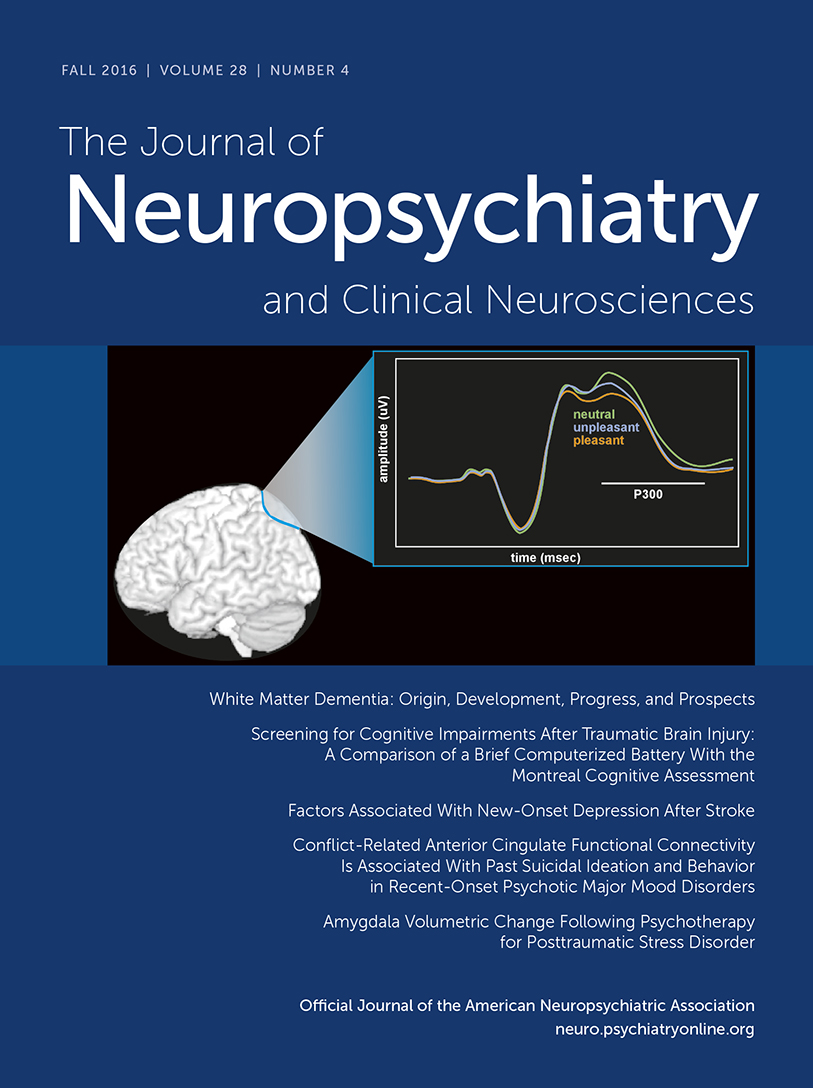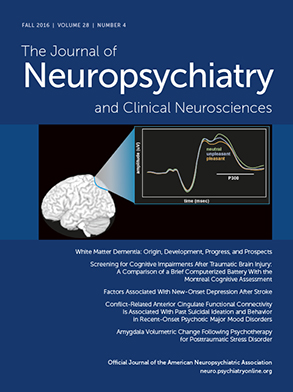The focus on physical signs has not been sufficiently considered by the current psychiatric diagnostic manuals, especially in anxiety disorders.
1 Detecting minor neurological signs is easily accessible by a simple neurological examination and could be a useful, if underused, tool in the diagnostic process and patient therapy.
Stress biomarkers in anxiety disorders are related to the hypothalamic-pituitary-adrenal axis, the immune system, the sympathetic-adrenal-medullary system, the cardiovascular system, the autonomic nervous system, and even the CNS.
2 Although these anxiety biomarkers have been important in research, their use has not been generalized to daily clinical practice. This may be attributable to (a) the high cost of laboratory and neuroimaging tests and (b) findings that are not entirely conclusive.
Despite the lack of research on minor signs in anxiety, particularly interesting data are available. For instance, abnormal fine motor movements correlate with anxiety in children.
3 Left-sided visuospatial soft signs are present in a subgroup of patients with obsessive-compulsive disorder and in those with poorer treatment response.
4 Neurological soft signs such as abnormal “copy figures” and “fist-palm-side” are present in patients with posttraumatic stress disorder (PTSD) relative to trauma-exposed controls.
5 Indeed, unexposed co-twins of combat veterans with PTSD had higher soft signs than unexposed co-twins of combat veterans without PTSD.
6 These findings suggested a genetic predisposition for the development of psychiatric conditions, which is reflected by neurological soft signs.
Regarding changes in the tactile sensitivity in anxiety disorders, López-Ibor
7 and Rojo-Sierra
8 proposed that people with “anguish” show hypoesthesia consisting of differences in sensitivity between the internal and external malleolar region of both feet, a soft sign that disappears when the anxiety is alleviated. López-Ibor
7 suggested that the origin of this disorder is central, not peripheral, because its distribution corresponds with the distribution of thalamic anesthetics and is not metameric. Many thalamic disorders, which are usually accompanied by affective disorders, produce hypoesthesia centered on the malleolar regions of the foot.
8 A recent study showed that individuals with depression who exhibited malleolar hypoesthesia had greater symptoms of anxiety depression.
9 However, these patients showed depressive disorder. Thus, the relationship between anxiety disorders and hypoesthesia remains unknown.
On the basis of our experience accumulated over decades through the systematic neurological examination of outpatients, we examined the malleolar sensitivity among patients with clinical anxiety to test the hypotheses of López-Ibor
7 and Rojo-Sierra.
8Methods
A total of 93 patients exhibiting an anxious state participated in this study. All patients were recruited from an outpatient unit in the Department of Psychiatry at La Fe University and Polytechnic Hospital (Valencia, Spain). There were 101 healthy individuals who served as a control group, and they were recruited through advertising in the community. Demographic and clinical details are presented in
Table 1.
The La Fe Health Research Institute Ethics Committee authorized this study. All participants gave written informed consent before taking part in the experiment. Patients fulfilled the ICD-10
10 criteria for generalized anxiety disorder (F41.1) or mixed anxiety-depressive disorder (F41.2). Clinical interviews and case note reviews were used to establish the diagnoses by the psychiatrist in charge. In addition, ICD-10 diagnoses were corroborated by a postgraduate psychiatric intern. The exclusion criteria for participants were neurological history and/or other psychiatric diagnoses at the time of assessment. Two clinical scales were applied: the State-Trait Anxiety Inventory
11 and the Hamilton Rating Scale for Depression.
12To determine the presence of hypoesthesia, we examined the participants using the Wartenberg wheel, a medical device for neurological use, as part of a neurological clinical examination. Physicians who were unaware of our study’s hypothesis and had experience in neurological assessment explored the differences in tactile sensitivity between both limbs, with the patient in a seated position. To determine the presence of tactile hypoesthesia, we used the Wartenberg wheel on both ankle malleoli, internal and external. Participants were asked to identify whether the sensation was the same on one side as the other. Hypoesthesia was classified as the presence of unequal sensitivity between the malleoli of one ankle.
We used a chi-square test to compare differences between the groups. In addition, binary classification data were calculated to obtain sensitivity, positive predictive values (PPVs), and negative predictive values (NPVs). Subsequently, a Student’s t test was performed to test whether there were differences in anxiety and depression scores as a function of whether the participants manifested malleolar hypoesthesia.
Results
The chi-square test was conducted to examine whether patients with anxiety and healthy individuals differed in the presence of hypoesthesia. The chi-square test revealed a significant effect (χ2(1)=29.50, p<0.001). The anxiety group displayed a higher percentage of hypoesthesia than the control group (65.59% versus 26.73%, respectively). Binary classification data were calculated. Sensitivity was 65.59% (95% confidence interval [95% CI]=55.02%−75.14%), specificity was 73.27% (95% CI=63.54%−81.58%), PPV was 69.32% (95% CI=58.58%−78.71%), and NPV was 69.81% (95% CI=60.13%−78.35%).
We conducted the Student's t test to examine whether participants with versus those without hypoesthesia showed differences on anxiety and depression scores. The t test revealed a significant effect for anxiety (t(234)=–5.14, p<0.001) and a significant effect for depression (t(234)=–5.79, p<0.001). Participants with hypoesthesia showed higher anxiety scores than participants without hypoesthesia (mean ± SD=32.69±15.38 and 22.66±14.56, respectively). Participants with hypoesthesia also had higher depression scores than participants without hypoesthesia (mean ± SD=11.93±7.40, and 6.50±6.99, respectively).
Discussion
This study shows that patients with anxiety are generally more likely to present malleolar hypoesthesia than participants without psychopathology. Furthermore, the participants who manifested malleolar hypoesthesia showed greater anxiety symptoms as well as greater depressive symptoms at the time of assessment. Taken together, these findings corroborate that localized tactile sensitivity is altered in anxiety and correlates with symptoms of anxiety and depression, even on a subclinical level.
Our study demonstrates that hypoesthesia is present in anxiety disorders and not only in affective disorders.
9 Furthermore, we can add to the hypotheses proposed by López-Ibor
7 and Rojo-Sierra
8 that both people with anxiety disorders and with “anguish” exhibit hypoesthesia. Although this study has not tested whether the thalamus is the substrate of hypoesthesia, neurobiological abnormalities in the thalamus have been implicated in the pathogenesis of anxiety disorders.
13,14 Further research should focus on examining the possible causal link between thalamic innervations and tactile sensitivity in patients with anxiety.
One limitation of this study is the use of psychotropic medication among all of the participants. However, to our knowledge, there is no literature demonstrating an association between changes in tactile sensitivity with psychotropic medication (i.e., anxiolytics and antidepressants).
In summary, both patients with specific anxiety disorders and individuals who manifest symptoms of anxiety and depression generally exhibit dysfunction in tactile sensitivity in their lower limbs. To identify whether these signs are a state or trait,
5,6 future research should corroborate whether this minor sign disappears or, contrarily, remains constant in individuals who no longer manifest anxiety symptoms.

